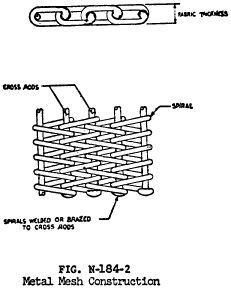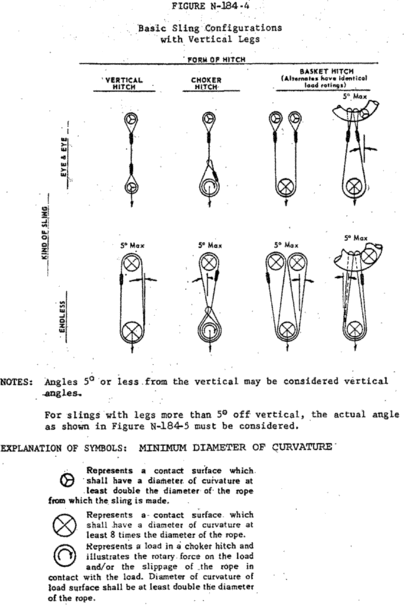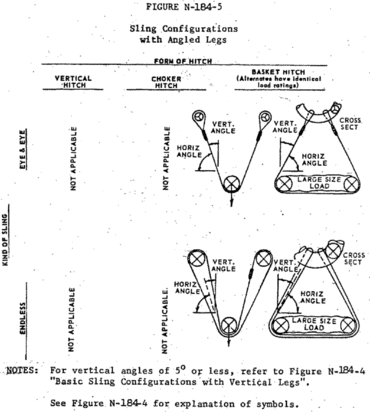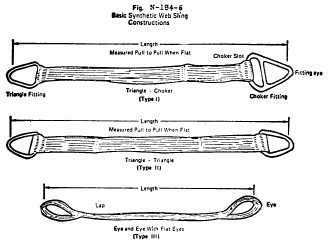Title 29
SECTION 1910.184
1910.184 Slings.
§ 1910.184 Slings.(a) Scope. This section applies to slings used in conjunction with other material handling equipment for the movement of material by hoisting, in employments covered by this part. The types of slings covered are those made from alloy steel chain, wire rope, metal mesh, natural or synthetic fiber rope (conventional three strand construction), and synthetic web (nylon, polyester, and polypropylene).
(b) Definitions. Angle of loading is the inclination of a leg or branch of a sling measured from the horizontal or vertical plane as shown in Fig. N-184-5; provided that an angle of loading of five degrees or less from the vertical may be considered a vertical angle of loading.
Basket hitch is a sling configuration whereby the sling is passed under the load and has both ends, end attachments, eyes or handles on the hook or a single master link.
Braided wire rope is a wire rope formed by plaiting component wire ropes.
Bridle wire rope sling is a sling composed of multiple wire rope legs with the top ends gathered in a fitting that goes over the lifting hook.
Cable laid endless sling-mechanical joint is a wire rope sling made endless by joining the ends of a single length of cable laid rope with one or more metallic fittings.
Cable laid grommet-hand tucked is an endless wire rope sling made from one length of rope wrapped six times around a core formed by hand tucking the ends of the rope inside the six wraps.
Cable laid rope is a wire rope composed of six wire ropes wrapped around a fiber or wire rope core.
Cable laid rope sling-mechanical joint is a wire rope sling made from a cable laid rope with eyes fabricated by pressing or swaging one or more metal sleeves over the rope junction.
Choker hitch is a sling configuration with one end of the sling passing under the load and through an end attachment, handle or eye on the other end of the sling.
Coating is an elastomer or other suitable material applied to a sling or to a sling component to impart desirable properties.
Cross rod is a wire used to join spirals of metal mesh to form a complete fabric. (See Fig. N-184-2.)
Designated means selected or assigned by the employer or the employer's representative as being qualified to perform specific duties.
Equivalent entity is a person or organization (including an employer) which, by possession of equipment, technical knowledge and skills, can perform with equal competence the same repairs and tests as the person or organization with which it is equated.
Fabric (metal mesh) is the flexible portion of a metal mesh sling consisting of a series of transverse coils and cross rods.
Female handle (choker) is a handle with a handle eye and a slot of such dimension as to permit passage of a male handle thereby allowing the use of a metal mesh sling in a choker hitch. (See Fig. N-184-1.)
Handle is a terminal fitting to which metal mesh fabric is attached. (See Fig. N-184-1.)
Handle eye is an opening in a handle of a metal mesh sling shaped to accept a hook, shackle or other lifting device. (See Fig. N-184-1.)
Hitch is a sling configuration whereby the sling is fastened to an object or load, either directly to it or around it.
Link is a single ring of a chain.
Male handle (triangle) is a handle with a handle eye.
Master coupling link is an alloy steel welded coupling link used as an intermediate link to join alloy steel chain to master links. (See Fig. N-184-3.)
Master link or gathering ring is a forged or welded steel link used to support all members (legs) of an alloy steel chain sling or wire rope sling. (See Fig. N-184-3.)
Mechanical coupling link is a nonwelded, mechanically closed steel link used to attach master links, hooks, etc., to alloy steel chain.





Proof load is the load applied in performance of a proof test.
Proof test is a nondestructive tension test performed by the sling manufacturer or an equivalent entity to verify construction and workmanship of a sling.
Rated capacity or working load limit is the maximum working load permitted by the provisions of this section.
Reach is the effective length of an alloy steel chain sling measured from the top bearing surface of the upper terminal component to the bottom bearing surface of the lower terminal component.
Selvage edge is the finished edge of synthetic webbing designed to prevent unraveling.
Sling is an assembly which connects the load to the material handling equipment.
Sling manufacturer is a person or organization that assembles sling components into their final form for sale to users.
Spiral is a single transverse coil that is the basic element from which metal mesh is fabricated. (See Fig. N-184-2.)
Strand laid endless sling-mechanical joint is a wire rope sling made endless from one length of rope with the ends joined by one or more metallic fittings.
Strand laid grommet-hand tucked is an endless wire rope sling made from one length of strand wrapped six times around a core formed by hand tucking the ends of the strand inside the six wraps.
Strand laid rope is a wire rope made with strands (usually six or eight) wrapped around a fiber core, wire strand core, or independent wire rope core (IWRC).
Vertical hitch is a method of supporting a load by a single, vertical part or leg of the sling. (See Fig. N-184-4.)
(c) Safe operating practices. Whenever any sling is used, the following practices shall be observed:
(1) Slings that are damaged or defective shall not be used.
(2) Slings shall not be shortened with knots or bolts or other makeshift devices.
(3) Sling legs shall not be kinked.
(4) Slings shall not be loaded in excess of their rated capacities.
(5) Slings used in a basket hitch shall have the loads balanced to prevent slippage.
(6) Slings shall be securely attached to their loads.
(7) Slings shall be padded or protected from the sharp edges of their loads.
(8) Suspended loads shall be kept clear of all obstructions.
(9) All employees shall be kept clear of loads about to be lifted and of suspended loads.
(10) Hands or fingers shall not be placed between the sling and its load while the sling is being tightened around the load.
(11) Shock loading is prohibited.
(12) A sling shall not be pulled from under a load when the load is resting on the sling.
(13) Employers must not load a sling in excess of its recommended safe working load as prescribed by the sling manufacturer on the identification markings permanently affixed to the sling.
(14) Employers must not use slings without affixed and legible identification markings.
(d) Inspections. Each day before being used, the sling and all fastenings and attachments shall be inspected for damage or defects by a competent person designated by the employer. Additional inspections shall be performed during sling use, where service conditions warrant. Damaged or defective slings shall be immediately removed from service.
(e) Alloy steel chain slings - (1) Sling identification. Alloy steel chain slings shall have permanently affixed durable identification stating size, grade, rated capacity, and reach.
(2) Attachments. (i) Hooks, rings, oblong links, pear shaped links, welded or mechanical coupling links or other attachments shall have a rated capacity at least equal to that of the alloy steel chain with which they are used or the sling shall not be used in excess of the rated capacity of the weakest component.
(ii) Makeshift links or fasteners formed from bolts or rods, or other such attachments, shall not be used.
(3) Inspections. (i) In addition to the inspection required by paragraph (d) of this section, a thorough periodic inspection of alloy steel chain slings in use shall be made on a regular basis, to be determined on the basis of (A) frequency of sling use; (B) severity of service conditions; (C) nature of lifts being made; and (D) experience gained on the service life of slings used in similar circumstances. Such inspections shall in no event be at intervals greater than once every 12 months.
(ii) The employer shall make and maintain a record of the most recent month in which each alloy steel chain sling was thoroughly inspected, and shall make such record available for examination.
(iii) The thorough inspection of alloy steel chain slings shall be performed by a competent person designated by the employer, and shall include a thorough inspection for wear, defective welds, deformation and increase in length. Where such defects or deterioration are present, the sling shall be immediately removed from service.
(4) Proof testing. The employer shall ensure that before use, each new, repaired, or reconditioned alloy steel chain sling, including all welded components in the sling assembly, shall be proof tested by the sling manufacturer or equivalent entity, in accordance with paragraph 5.2 of the American Society of Testing and Materials Specification A391-65, which is incorporated by reference as specified in § 1910.6 (ANSI G61.1-1968). The employer shall retain a certificate of the proof test and shall make it available for examination.
(5) [Reserved]
(6) Safe operating temperatures. Employers must permanently remove an alloy steel-chain slings from service if it is heated above 1000 degrees F. When exposed to service temperatures in excess of 600 degrees F, employers must reduce the maximum working-load limits permitted by the chain manufacturer in accordance with the chain or sling manufacturer's recommendations.
(7) Repairing and reconditioning alloy steel chain slings. (i) Worn or damaged alloy steel chain slings or attachments shall not be used until repaired. When welding or heat testing is performed, slings shall not be used unless repaired, reconditioned and proof tested by the sling manufacturer or an equivalent entity.
(ii) Mechanical coupling links or low carbon steel repair links shall not be used to repair broken lengths of chain.
(8) Effect of wear. If the chain size at any point of the link is less than that stated in Table N-184-1, the employer must remove the chain from service.
(9) Deformed attachments. (i) Alloy steel chain slings with cracked or deformed master links, coupling links or other components shall be removed from service.
Table N-184-1 - Minimum Allowable Chain Size At Any Point of Link
| Chain size, inches | Minimum allowable chain size, inches |
|---|---|
| 1/4 | 13/64 |
| 3/8 | 19/64 |
| 1/2 | 25/64 |
| 5/8 | 31/64 |
| 3/4 | 19/32 |
| 7/8 | 4 5/64 |
| 1 | 13/16 |
| 1 1/8 | 29/32 |
| 1 1/4 | 1 |
| 1 3/8 | 1 3/32 |
| 1 1/2 | 1 3/16 |
| 1 3/4 | 1 13/32 |
(ii) Slings shall be removed from service if hooks are cracked, have been opened more than 15 percent of the normal throat opening measured at the narrowest point or twisted more than 10 degrees from the plane of the unbent hook.
(f) Wire-rope slings - (1) Sling use. Employers must use only wire-rope slings that have permanently affixed and legible identification markings as prescribed by the manufacturer, and that indicate the recommended safe working load for the type(s) of hitch(es) used, the angle upon which it is based, and the number of legs if more than one.
(2) Minimum sling lengths. (i) Cable laid and 6 × 19 and 6 × 37 slings shall have a minimum clear length of wire rope 10 times the component rope diameter between splices, sleeves or end fittings.
(ii) Braided slings shall have a minimum clear length of wire rope 40 times the component rope diameter between the loops or end fittings.
(iii) Cable laid grommets, strand laid grommets and endless slings shall have a minimum circumferential length of 96 times their body diameter.
(3) Safe operating temperatures. Fiber core wire rope slings of all grades shall be permanently removed from service if they are exposed to temperatures in excess of 200 °F. When nonfiber core wire rope slings of any grade are used at temperatures above 400 °F or below minus 60 °F, recommendations of the sling manufacturer regarding use at that temperature shall be followed.
(4) End attachments. (i) Welding of end attachments, except covers to thimbles, shall be performed prior to the assembly of the sling.
(ii) All welded end attachments shall not be used unless proof tested by the manufacturer or equivalent entity at twice their rated capacity prior to initial use. The employer shall retain a certificate of the proof test, and make it available for examination.
(5) Removal from service. Wire rope slings shall be immediately removed from service if any of the following conditions are present:
(i) Ten randomly distributed broken wires in one rope lay, or five broken wires in one strand in one rope lay.
(ii) Wear or scraping of one-third the original diameter of outside individual wires.
(iii) Kinking, crushing, bird caging or any other damage resulting in distortion of the wire rope structure.
(iv) Evidence of heat damage.
(v) End attachments that are cracked, deformed or worn.
(vi) Hooks that have been opened more than 15 percent of the normal throat opening measured at the narrowest point or twisted more than 10 degrees from the plane of the unbent hook.
(vii) Corrosion of the rope or end attachments.
(g) Metal mesh slings - (1) Sling marking. Each metal mesh sling shall have permanently affixed to it a durable marking that states the rated capacity for vertical basket hitch and choker hitch loadings.
(2) Handles. Handles shall have a rated capacity at least equal to the metal fabric and exhibit no deformation after proof testing.
(3) Attachments of handles to fabric. The fabric and handles shall be joined so that:
(i) The rated capacity of the sling is not reduced.
(ii) The load is evenly distributed across the width of the fabric.
(iii) Sharp edges will not damage the fabric.
(4) Sling coatings. Coatings which diminish the rated capacity of a sling shall not be applied.
(5) Sling testing. All new and repaired metal mesh slings, including handles, shall not be used unless proof tested by the manufacturer or equivalent entity at a minimum of 1 1/2 times their rated capacity. Elastomer impregnated slings shall be proof tested before coating.
(6) [Reserved]
(7) Safe operating temperatures. Metal mesh slings which are not impregnated with elastomers may be used in a temperature range from minus 20 °F to plus 550 °F without decreasing the working load limit. Metal mesh slings impregnated with polyvinyl chloride or neoprene may be used only in a temperature range from zero degrees to plus 200 °F. For operations outside these temperature ranges or for metal mesh slings impregnated with other materials, the sling manufacturer's recommendations shall be followed.
(8) Repairs. (i) Metal mesh slings which are repaired shall not be used unless repaired by a metal mesh sling manufacturer or an equivalent entity.
(ii) Once repaired, each sling shall be permanently marked or tagged, or a written record maintained, to indicate the date and nature of the repairs and the person or organization that performed the repairs. Records of repairs shall be made available for examination.
(9) Removal from service. Metal mesh slings shall be immediately removed from service if any of the following conditions are present:
(i) A broken weld or broken brazed joint along the sling edge.
(ii) Reduction in wire diameter of 25 per cent due to abrasion or 15 per cent due to corrosion.
(iii) Lack of flexibility due to distortion of the fabric.
(iv) Distortion of the female handle so that the depth of the slot is increased more than 10 per cent.
(v) Distortion of either handle so that the width of the eye is decreased more than 10 per cent.
(vi) A 15 percent reduction of the original cross sectional area of metal at any point around the handle eye.
(vii) Distortion of either handle out of its plane.
(h) Natural and synthetic fiber-rope slings - (1) Sling use. Employers must use natural and synthetic fiber-rope slings that have permanently affixed and legible identification markings stating the rated capacity for the type(s) of hitch(es) used and the angle upon which it is based, type of fiber material, and the number of legs if more than one.
(2) Safe operating temperatures. Natural and synthetic fiber rope slings, except for wet frozen slings, may be used in a temperature range from minus 20 °F to plus 180 °F without decreasing the working load limit. For operations outside this temperature range and for wet frozen slings, the sling manufacturer's recommendations shall be followed.
(3) Splicing. Spliced fiber rope slings shall not be used unless they have been spliced in accordance with the following minimum requirements and in accordance with any additional recommendations of the manufacturer:
(i) In manila rope, eye splices shall consist of at least three full tucks, and short splices shall consist of at least six full tucks, three on each side of the splice center line.
(ii) In synthetic fiber rope, eye splices shall consist of at least four full tucks, and short splices shall consist of at least eight full tucks, four on each side of the center line.
(iii) Strand end tails shall not be trimmed flush with the surface of the rope immediately adjacent to the full tucks. This applies to all types of fiber rope and both eye and short splices. For fiber rope under one inch in diameter, the tail shall project at least six rope diameters beyond the last full tuck. For fiber rope one inch in diameter and larger, the tail shall project at least six inches beyond the last full tuck. Where a projecting tail interferes with the use of the sling, the tail shall be tapered and spliced into the body of the rope using at least two additional tucks (which will require a tail length of approximately six rope diameters beyond the last full tuck).
(iv) Fiber rope slings shall have a minimum clear length of rope between eye splices equal to 10 times the rope diameter.
(v) Knots shall not be used in lieu of splices.
(vi) Clamps not designed specifically for fiber ropes shall not be used for splicing.
(vii) For all eye splices, the eye shall be of such size to provide an included angle of not greater than 60 degrees at the splice when the eye is placed over the load or support.
(4) End attachments. Fiber rope slings shall not be used if end attachments in contact with the rope have sharp edges or projections.
(5) Removal from service. Natural and synthetic fiber rope slings shall be immediately removed from service if any of the following conditions are present:
(i) Abnormal wear.
(ii) Powdered fiber between strands.
(iii) Broken or cut fibers.
(iv) Variations in the size or roundness of strands.
(v) Discoloration or rotting.
(vi) Distortion of hardware in the sling.
(6) Repairs. Only fiber rope slings made from new rope shall be used. Use of repaired or reconditioned fiber rope slings is prohibited.
(i) Synthetic web slings - (1) Sling identification. Each sling shall be marked or coded to show the rated capacities for each type of hitch and type of synthetic web material.
(2) Webbing. Synthetic webbing shall be of uniform thickness and width and selvage edges shall not be split from the webbing's width.
(3) Fittings. Fittings shall be:
(i) Of a minimum breaking strength equal to that of the sling; and
(ii) Free of all sharp edges that could in any way damage the webbing.
(4) Attachment of end fittings to webbing and formation of eyes. Stitching shall be the only method used to attach end fittings to webbing and to form eyes. The thread shall be in an even pattern and contain a sufficient number of stitches to develop the full breaking strength of the sling.
(5) [Reserved]
(6) Environmental conditions. When synthetic web slings are used, the following precautions shall be taken:
(i) Nylon web slings shall not be used where fumes, vapors, sprays, mists or liquids of acids or phenolics are present.
(ii) Polyester and polypropylene web slings shall not be used where fumes, vapors, sprays, mists or liquids of caustics are present.
(iii) Web slings with aluminum fittings shall not be used where fumes, vapors, sprays, mists or liquids of caustics are present.


(7) Safe operating temperatures. Synthetic web slings of polyester and nylon shall not be used at temperatures in excess of 180 °F. Polypropylene web slings shall not be used at temperatures in excess of 200 °F.
(8) Repairs. (i) Synthetic web slings which are repaired shall not be used unless repaired by a sling manufacturer or an equivalent entity.
(ii) Each repaired sling shall be proof tested by the manufacturer or equivalent entity to twice the rated capacity prior to its return to service. The employer shall retain a certificate of the proof test and make it available for examination.
(iii) Slings, including webbing and fittings, which have been repaired in a temporary manner shall not be used.
(9) Removal from service. Synthetic web slings shall be immediately removed from service if any of the following conditions are present:
(i) Acid or caustic burns;
(ii) Melting or charring of any part of the sling surface;
(iii) Snags, punctures, tears or cuts;
(iv) Broken or worn stitches; or
(v) Distortion of fittings.
[40 FR 27369, June 27, 1975, as amended at 40 FR 31598, July 28, 1975; 41 FR 13353, Mar. 30, 1976; 58 FR 35309, June 30, 1993; 61 FR 9240, Mar. 7, 1996; 76 FR 33607, June 8, 2011; 84 FR 15105, Apr. 15, 2019]